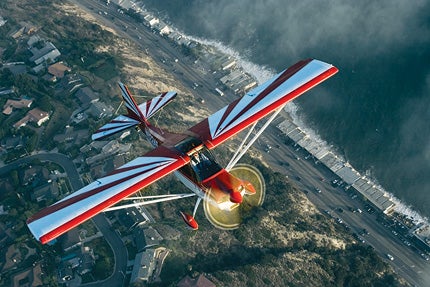The Most Affordable Singles
We examine some of the best buys In general aviation
|
While our last buyer's guide ["Buyer's Mini-Guide To Four-Seat Singles," P&P April 2010] included a smorgasbord of new airplanes, this one deals with used aircraft and draws from an even wider field. For this effort, we set a top price of $200,000. We could argue all day about whether $200,000 is "affordable," but we feel that it's a reasonable compromise---more than enough, but less than too much. Alternatively, two hundred large might buy you a decent timeshare in Aspen, an exotic sports car or a twin-engine cabin cruiser for fishing in the Gulf of Mexico.
Because there are few new airplanes available for $200,000 or less (except for LSA), this list comprises what we feel are the best used buys on the market. To avoid including antiques, whose value often is more intrinsic than practical, we set an age limit of 25 years. That's not because older models can't be made to look and fly young, but because reliability could be compromised on flying machines suffering from the aviation equivalent of middle age.
All pricing information is courtesy of RVI's Aircraft Bluebook Price Digest, Winter 2009/2010, but keep in mind that despite the depressed market, primo examples of older planes (between 1985 and 1995) probably will have been upgraded with Garmin 430/530 radios, making them worth a little more than usual.
And now, we offer our list of the most affordable singles in general aviation. (Let the e-mails begin.)
1 AMERICAN CHAMPION SUPER DECATHLON 8KCAB: Some planes are intended for fun---the Super Decathlon certainly is one of these airplanes. With 180 hp out front and enough aerobatic chops to handle all but the most exotic maneuvers, the 8KCAB can serve as a basic trainer or an acro bird. Additionally, it makes a fun, comfortable cross-country airplane, with an easy 1,200 fpm climb and reasonable 128-knot cruise speed. With 40 gallons in the tanks and a baggage compartment behind the aft seat, you can load up to two lightweights and a suitcase, and take the airplane on 350 nm cross-countries. Originally a Champion, then a Bellanca and now an American Champion, the Super Decathlon still is in production. You can purchase most 8KCABs for less than our target price of $200,000.
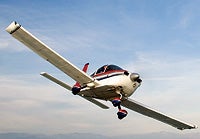 American General Tiger |
2 AMERICAN GENERAL AA-5B TIGER: The Tiger has a huge fan club. It's certainly one of the most popular airplanes that's not in production (though the type-certificate owner, True Flight Aerospace of Valdosta, Ga., hopes to reintroduce it). What endeared the Tiger to two generations of pilots was the quickest handling in the class and surprising performance for only 180 hp and fixed gear. With a sliding hatch to trick your friends into thinking you're a retired fighter pilot, bonded construction and a basically clean design, the Tiger offers performance equal to that of slower 200 hp retractables---800 fpm climb and a 135-knot cruise. You can find Tiger models from as late as 2005 (under the Tiger Aircraft banner), and all fall below our $200,000 ceiling.
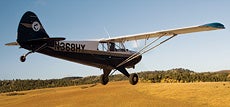 Husky A-1C |
3 AVIAT HUSKY A-1: If your mission is utility flying, you'd be hard-pressed to find an airplane better suited to hard knocks than the Aviat Husky. Though the top-of-the-line 200 hp 2010 Husky A-1C is priced at well over $350,000, the type dates back to 1988, and $200,000 will buy you an example from as late as 2009. The A-1A, A-1B and A-1C are similar airplanes separated by carbureted 180 hp, injected 180 hp and injected 200 hp, respectively. Like the Super Cub it emulates, the Husky does its best work in short-field mode. Runway requirements can be less than 500 feet, and a full-jump takeoff effort gets the airplane in the air in half that length. Adaptable to oversized bush wheels, skis and floats, the Husky covers all bases in the outback. All but the last two years' production of Huskys sell for $200,000 or less.
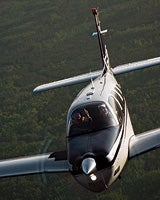 Bonanza G36 |
4 BEECH F33A BONANZA: The F33A was discontinued in 1994 (perhaps coincidentally, the same year Mooney introduced the Ovation). That doesn't subtract a whit from the ultimate four-seat Bonanza's talents, however. Certified in the utility class, the straight-tail airplane is stronger than most other machines. There even was an aerobatic model, the E33C, approved for most basic vertical and horizontal maneuvers. Bonanzas will outhandle most other machines in the class, offering uncommon control harmony and 170-knot speed. It also has the distinction of being what many pilots consider the best single-engine machine in the sky. Bonanzas from 1985 through 1994 generally sell for $200,000 or less.
5 BEECH A36 BONANZA: Add two seats to an F33A, and you'll wind up with an A36, an airplane that's currently in production as the G36 ("G" for Garmin). All the six-seat Bonanzas are regarded as top-end airplanes with performance roughly comparable to the aforementioned F33A. The right side aft double cargo doors make loading the rear seats easy, though the stretch from four to six seats eliminated the baggage compartment. Fuel capacity remains a low 74 gallons on all model 36 Bonanzas, but even so, the airplane can't carry full fuel and full seats. All airplanes after 1983 employed the 300 hp Continental IO-520, so cruise fuel burn ran about 17 gph, and endurance was 3.5 hours plus reserve at high cruise. Model 36s from 1985 to 1992 usually sell for $200,000 or less.
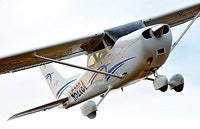 Cessna 172 |
6 CESSNA SKYHAWK 172: The Skyhawk's undeniable popularity virtually guarantees it will appear on any best buy list. The fact is that Skyhawks always have been among the easiest-flying airplanes available, one reason they're often used for flight training. Today, Cessna only builds the 180 hp 172 S, but prior to last year, the 160 hp 172R also was available. Typical of big wings and mid-powered engines, the Skyhawk does its best work coming off and back onto the ground, easily operating out of 2,000-foot runways. Count on a 120-knot cruise following a 700 fpm climb. You can purchase a Skyhawk as late as 2008 for $200,000.
 Cessna 182 |
7 CESSNA SKYLANE 182: Unlike its little brother, the 230 hp Skylane boasts performance that's near that of the old bottom-level, 200 hp retractables, despite dragging fixed gear underneath and struts on either side. Many pilots regard the Skylane as the best four-seat family airplane on the market, capable of lifting two adults and two kids at 850 fpm, and transporting them for four hours at 135 to 140 knots. The Skylane flies on instruments as if mounted on rails, is stable in turbulence and is generally regarded as every pilot's best friend. If you have $200,000 to spend, you should be able to find a Skylane as new as 2005. The turbocharged model became available in 2001, and they're available for less than $200,000 through about 2004.
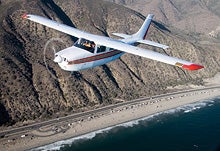 Cessna 210 |
8 CESSNA CENTURION 210: Cessna's premier single-engine traveling machine has a following that's nearly as fanatical as fans of the straight-tail Bonanzas. Indeed, the retractable 210 spanned the market from normally aspirated and turbocharged to pressurized. The normal airplane managed to haul 4+2 with relative ease, traveling at 165 to 170 knots. Turbocharging upped the speed ante to as much as 200 knots at 25,000 feet. With their large, strutless wings and huge flaps, Centurions shared with the Skylane good short-field characteristics, though the folding gear was less adaptable to rough fields. Fuel capacity typically was 90 gallons, and the 285 hp Continental burned 16 to 17 gph, so endurance was 4.5 hours plus reserve, worth 800 nm range. Only models from the last two years of production, the 210R and T210R, qualify as younger than 25 years old, and both airplanes occasionally are available for less than $200,000.
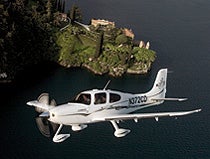 Cirrus SR22 |
9 CIRRUS SR22: Dale and Alan Klapmeier's innovative composite design has been with us for nearly a full decade, and in recent years, it has even outsold the Skyhawk. That's partially because the SR22 represents all-new technology, with a glass panel to preclude getting lost, a side stick rather than a conventional yoke, a ballistic parachute system to provide the ultimate hedge against engine failure and a cabin configured after a BMW 5 Series. The slick composite surface presented a smooth surface to the wind, and in combination with a 310 hp Continental IO-550, the airplane cruised at 180 knots. Model years 2001, 2002 and 2003 typically sell for $200,000 or less.
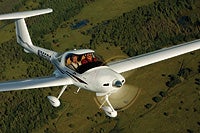 Diamond DA40 |
10 DIAMOND DA40 STAR: An outgrowth of the two-seat Diamond Eclipse, the Star is the Austrian company's current four-seat, everyman's single. In addition to joystick control and an ultimately maneuverable, nonsteerable nosewheel, the Star has an aft left entry door for rear-seat passengers. Like the beloved Tiger, the Star delivers a 1,000 fpm climb rate and uncommon speed on only 180 hp, about 140 to 145 knots. The cabin is larger than the Tiger's, however, and the Star will carry additional weight. Stars appeared on the market in 2000, and airplanes through 2007 have price tags below $200,000.
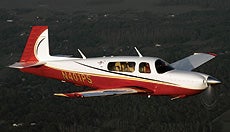 Mooney Ovation |
11 MOONEY OVATION M20R: Mooneys of every description always have been renowned for their speed and efficiency. The Ovation represents perhaps the supreme compromise of horsepower/fuel burn with cruise speed, meanwhile offering the long cabin of the Porsche Mooney, TLS/Bravo and Eagle. Yet, the Ovation flies faster than any other normally aspirated production model. I delivered 10 of the type to Australia in the '90s, and I could count on an easy 185 knots at normal weights. Better still, the Ovation can be throttled back to deliver 170 knots on about 12.5 gph, another benefit for long-distance flyers. Mooneys from 1994 to 1998 typically sell for $200,000 or less.
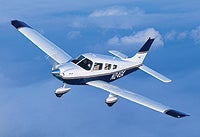 Piper Archer |
12 PIPER ARCHER PA28-180: It seems that Archers have been around forever in one form or another, and they're being reintroduced for 2010. The type is perhaps the world's easiest-flying and most benign fixed-gear airplane. Even Skyhawk fans acknowledge that the Archer's stall may be the gentlest in the industry. Instructors have even criticized it as being too benign, as if any airplane could be too safe. Cruise is a reasonable 120 knots or so, but the Archer's major achievement is a usable four seats, if with reduced fuel. Archers from 1985 to 2006 most often sell for $200,000 or less.
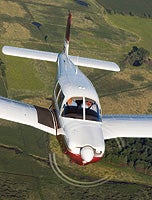 Piper Arrow |
13 PIPER ARROW PA28-200: Put the wheels to bed on an Archer and add a constant-speed prop and 20 more hp, and you have an Arrow. The original Arrow's claim to fame was an automatic gear-extension system that was decommissioned a few years later (you guessed it: a lawsuit). In addition to a relatively foolproof gear system (originally), the Arrow added about 10 to 15 knots to cruise, but more important, it provided a step-up airplane for pilots trained in Pipers (i.e., aviators who preferred low wings without struts). The premise was to prepare pilots for the six-seat Cherokee Six or Saratoga. Arrows from 1985 through 2005 are priced at $200,000 or less.
14 PIPER SARATOGA/SP PA32-300(R): Probably the best economy six-seater on the market, the Cherokee Six/Saratoga/HP was a stalwart of the Piper line for more than 40 years. The primogenitor of the Seneca, a twin-engine version of the same airplane, the original PA32 boasted oodles of elbow room in the cabin, plus a nose baggage compartment to help balance the load. The original Cherokee Six became the Saratoga and Turbo Saratoga, and the Saratoga HP was a Cherokee Six with retractable gear. The 6X offered a 145-knot cruise, and the Saratoga HP added 15 knots. All models in the PA32 line could carry six folks with large double aft left cargo doors to help load the aft four. Saratogas through 1995 usually are priced at or below $200,000.
 Diamond DA20 |
15 DIAMOND DA20: Diamond's interpretation of the ultimate aviation teaching machine is a slightly smaller version of the four-seat DA40 Star. The DA20 Eclipse (yes, Diamond had it first) uses the same 125 hp Continental IO-240 engine as the Liberty XL2, though not the FADEC edition. With its wide, comfortable cabin, excellent visibility and a stall speed well below 50 knots, the Eclipse makes a capable trainer as well as a reasonable traveling machine. Cruise is an impressive 135 to 138 knots. The airplane is certified in the utility category. It's spinnable, so students can train for spin recovery if they choose. All models of the DA20 Eclipse (except the 2010 version) are available for less than our $200,000 target price.
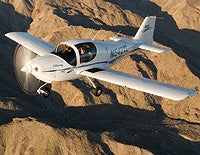 Liberty XL2 |
16 LIBERTY XL2: The two-seat Liberty XL2's primary claim to fame is that it was one of the first airplanes to embrace FADEC (full authority digital engine control). The Liberty employs a computer-controlled, 125 hp Continental IOF-240-B that manages all parameters of engine management automatically. An obvious benefit of computer control is efficiency, and the XL2 scores about 5.3 gph at 60% power. Liberty sells the airplane as a trainer or personal transport, and it's a comfortable machine in either mode, with a 48-inch-wide cabin. Cruise is 125 knots at max throttle and 7,000 feet. If you have a budget of $200,000, you should be able to buy a used XL2 Vanguard from as late as 2008 to 2009.
Improvements To The Breed
|
| Perhaps contrary to popular belief, several of the airplanes in this article have experienced changes in the last quarter century. Cessna's Skyhawk, the world's most popular airplane until a few years ago, has undergone some upgrades since its revival in 1997. Though Cessna switched to Lycoming engines with the reintroduction of the Skyhawk, Skylane and Stationair, the Skyhawk was offered in two hp configurations: 160 hp on the 172R, and 180 hp on the 172S. Performance differences were minor, though the S version of the Skyhawk obviously benefitted from slightly better climb and about one knot more cruise. Another major improvement in the Skyhawk was the Garmin G1000 glass-panel display. Today, Cessna has dropped the 172R and produces only the 172S.
Another popular Cessna, the Centurion, represented a major improvement in its 1995/1996 iterations. The airplane had been available in normally aspirated, turbocharged and pressurized versions for several years. For the last two years of production, Cessna upgraded the turbo and pressurized models from 300 hp to 325 hp, and added new wingtips to make the Cessna 210R more competitive with the Piper Malibu. The R version of the Centurion added about 100 fpm to climb, 15 knots to cruise and 100 pounds to payload. The Aviat Husky has been around since 1988, and again, the newest airplane retains the basic configuration while offering significant upgrades. The original Husky, A-1 and A-1B used the carbureted, 180 hp O-360-A1G/P, while the more recent A-1C employs the injected, 200 hp IO-360. Predictably, the extra 20 hp transforms the airplane's takeoff and climb performance from spectacular to just short of unbelievable. Huskys have assumed the old Super Cub's place at the top of the bush bird pyramid, and the A-1C only continues that tradition and widens the gap between the competition. |
Owner Stories
|
||
Cessna 172 The Gulfstream pilot says everyone in his family is a pilot---wife, son and daughter---and all appreciate the Skyhawk's gentle flight characteristics: "Everyone flies it, and everyone loves it." Cessna 182 "As a result, I bought a normally aspirated 2004 Skylane from Tom's Aircraft in Long Beach, Calif., and my friends' estimation of the airplane's talents was right on," says Whitton. The paving contractor upgraded his avionics to the active traffic L-3 SkyWatch system and stepped up to synthetic vision, but other than that, he has left the airplane intact. He uses the airplane for a wide range of missions, including business travel, new-job scouting, Sunday morning hamburgers and trips to the Bay Area to visit his daughter. Whitton has logged some 230 hours in his 182, and he has no plans to upgrade for some time: "The Skylane carries a ton of fuel, so I can fly for as long as I want. It's not the fastest airplane in the sky, but I'm not in that big a hurry anyway, so overall, I'm very happy with my Skylane." Diamond Star Summers purchased a Diamond Star demonstrator, and he has never looked back. "I fly the Star about 200 hours a year, and it's very hard to beat, especially for trips to Vegas. My business partner and I can fly on our own schedule with all the luggage we want and not have to worry about the inconveniences of commercial airlines. Plus, it's an enjoyable experience. I love the Garmin G1000, and operating costs are pretty reasonable with two people traveling most of the time." Summers also flies for fun about half the time. He and his family have been across the United States to Long Island, N.Y., and to Washington, D.C. Now instrument-rated, Summers says he never knows where he's going next. "I really enjoy the Star. I'd love to have a Bonanza or Saratoga, but when I weigh the costs against the benefits, the Star wins every time." Liberty XL2 Green and his aviation partner had looked at a variety of aircraft, including a Warrior, Skyhawk and Cirrus, when they discovered the Liberty XL2. "It was exactly what we wanted: all metal, FADEC, single-lever control, low wing and comfortable cabin for two. We were impressed," explains Green. After the Liberty was certified, the partners took delivery of their airplane two years ago. "As a TV and motion-picture lighting specialist, I've flown the Liberty all over the United States, including to satellite offices in New Orleans and Atlanta," says Green, "and though it's not the fastest airplane in the sky, it's very safe and simple, with push-tube controls, a single fuel tank and a wide, comfortable cabin. It's also a stable platform with great visibility, and it's very inexpensive to operate---only about 5.5 gph at high cruise." The Liberty is a two-seater, but Green says he and his partner call it a mini-Cirrus, the perfect compromise of efficiency, economy and size. Mooney Ovation After earning his private ticket in a Skyhawk, Dr. Spennato spent nearly a year looking at Piper Saratoga HPs, Beech G36 Bonanzas, Cessna Skylanes and other models before finally leasing a used Mooney Ovation. "The Ovation offered the best speed of any normally aspirated airplane on the market, better cabin room than the Bonanza and enough payload to let me fly to Utah nonstop," he explains. "Additionally, it's an efficient machine, capable of 170 knots on about 14 gph, or the full 185 knots at 17 gph." In the near future, Dr. Spennato plans to add an instrument rating to his credentials to make his Ovation even more valuable: "The Mooney is the perfect airplane for me, plus I have the advantage of passing almost every other piston single in the sky." |
||

Subscribe to Our Newsletter
Get the latest Plane & Pilot Magazine stories delivered directly to your inbox

